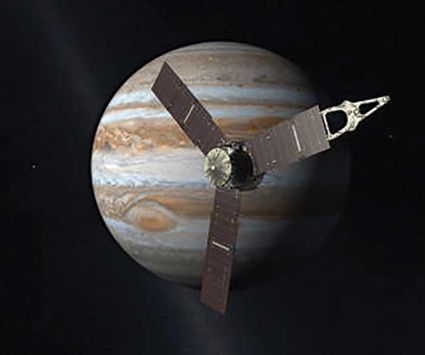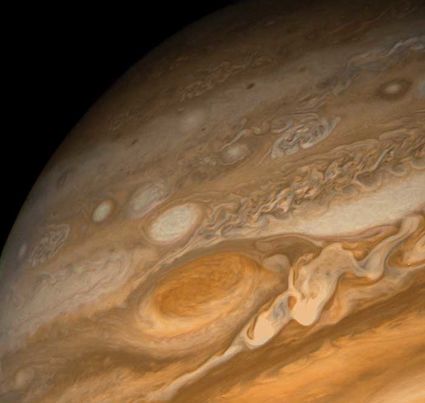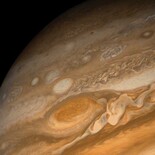Juno on Final Approach to Jupiter
Sky Watch

NASA/JPL
Juno's heart is dwarfed by its three huge solar power panels. At the end of the panel on the right is its magnetometer for characterizing Jupiter's intense magnetic field.
Launched almost five years ago, the NASA/JPL spacecraft Juno will arrive at Jupiter on July 4th to help us celebrate Independence Day. Its mission is to take a close look at the planet itself (as opposed to the entire Jovian system). We're trying to collect data that will help us understand the origin and evolution of Jupiter. This understanding is important since fully half of the planets in our system are gas giants like Jupiter (the others being Saturn, Uranus, and Neptune), and Jupiter is the largest of them all.
Specifically, Juno will try to determine whether Jupiter has a solid core, will precisely map its incredibly powerful gravitational and magnetic fields, measure the water and ammonia content deep into its atmosphere, and closely observe its auroras. To achieve this, Juno will fly highly elliptical polar orbits.
The name of the probe is very regal. Juno was the wife of the Roman god Jupiter; very classic. However, JPL says the name of the probe is derived from "JUpiter Near-polar Orbiter." I think Juno and Jupiter would be offended to hear that, the Olympian gods being an easily offended lot. Let us hope a Jovian thunderbolt doesn't smite our little craft for our hubris!
Juno has already set a number of records. It's the first spacecraft to venture to the outer planets on solar power. To date, all probes venturing beyond Mars have used radioisotope thermoelectric generators (RTG -- plutonium) for power, due to the weak sunlight. However, the efficiency of solar power panels has steadily improved, and the power demands of electronics have steadily decreased. Having made the solar panels large enough, Juno can get by nicely on the 400 watts they can supply at that distance.
As with all JPL probes, Juno is equipped with an impressive array of scientific instruments. A good summary can be found at en.wikipedia.org/wiki/Juno_(spacecraft).
The most unusual instrument is the JunoCam, a visible light camera/telescope intended primarily for public education and outreach. NASA has asked for input from the amateur astronomy community to help select targets. JunoCam is the one instrument that is more concerned about how beautiful an image is rather than its scientific valuable.
The upper atmosphere of Jupiter is an amazingly intricate and rich tapestry of multicolored festoons and ribbons. We never knew that until Voyager 1 sent back its images in 1979. Yet, today's best "amateur" telescopes and imaging techniques can show us the broad outlines of these details, easily outdoing Mount Palomar's 200-inch telescope in its glory days. You don't even need to own one; you can now rent time on such a telescope on a New Mexico mountain top from a basement in New York City!
The Juno mission will end in February of 2018 when the spacecraft will be deorbited into Jupiter's atmosphere to prevent any possible biological contamination of Europa or anywhere else.
The next planned mission to Jupiter is the European Space Agency's (ESA) Juice (JUpiter ICy moons Explorer) mission. With launch planned for 2022, it will be the first mission focused on Jupiter's moons since the NASA/JPL's Galileo mission ended in 2003.
Also in the pipeline is NASA's mission to send a probe to Jupiter's moon Europa, which has a global water-ocean under a crust of ice 15-25 km (10-15 mile) thick. Intrigued by the possibility of life in Europa's oceans, Congress not only authorized the mission, they directed NASA to use the new Space Launch System to launch it in 2022. On top of that, they directed NASA to include a lander, as well. It's not just a suggestion, it's the law. Congress even provided the money for it!
Planetary Postage Stamps
The U.S. Postal Service is releasing a new set of commemorative postage stamps of all eight planets. The dwarf planet Pluto will also be honored with its own stamp, along with the New Horizon spacecraft that is still downloading data and images from last July's flyby. The new stamps are due to be released between May 28 and June 4.
Almanac
Mars is in the process of relieving Jupiter from its evening "front and center" position high in the south. However, Jupiter is still bright in the southwest, not setting until nearly midnight as June opens.
It's Saturn's turn to reach opposition on June 2, rising at dusk and setting at dawn. With its rings still near maximum tilt, Saturn is in its best position for viewing. It will be highest at about 1 a.m., when much of the day's dust has settled out the air and the air is less turbulent.
With a new moon on Saturday, June 4, we have a prime opportunity for planet gazing.
Sunrise/Sunset: 5:41 a.m./8:03 p.m. (June 1st)
Community Star Parties
With the clearing skies and warm nights of summer ahead, it's time to put some star parties on the calendar. Astronomers love to share their passion for the night sky, and for their toys! Don't forget to bring your goodies for an evening picnic.

NASA/JPL
Voyager 1 first revealed the amazing intricacy of Jupiter's atmosphere in 1979. Juno will vastly enhance our understanding of this king of gas giant.
August 6: Brite Lake Star-B-Que. Hosted by the Antelope Valley Astronomy Club, Tehachapi Valley Recreation and Park District, and NASA/JPL Solar System Ambassadors. Activities begin at 6 p.m. and continue until dawn.
September 10: Tehachapi Aviator Park at Tehachapi Municipal Airport. Hosted by the City of Tehachapi, the Friends of Tehachapi Airport, the Greater Tehachapi Astronomy Club, and NASA/JPL Solar System Ambassadors.
Activities begin at 6 p.m. until 10 p.m.







